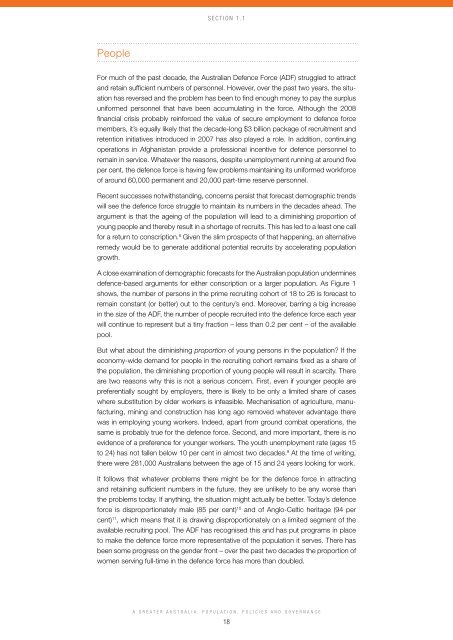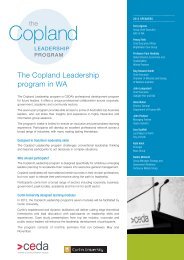A Greater Australia: Population, policies and governance - CEDA
A Greater Australia: Population, policies and governance - CEDA
A Greater Australia: Population, policies and governance - CEDA
- No tags were found...
Create successful ePaper yourself
Turn your PDF publications into a flip-book with our unique Google optimized e-Paper software.
Section 1.1PeopleFor much of the past decade, the <strong>Australia</strong>n Defence Force (ADF) struggled to attract<strong>and</strong> retain sufficient numbers of personnel. However, over the past two years, the situationhas reversed <strong>and</strong> the problem has been to find enough money to pay the surplusuniformed personnel that have been accumulating in the force. Although the 2008financial crisis probably reinforced the value of secure employment to defence forcemembers, it’s equally likely that the decade-long $3 billion package of recruitment <strong>and</strong>retention initiatives introduced in 2007 has also played a role. In addition, continuingoperations in Afghanistan provide a professional incentive for defence personnel toremain in service. Whatever the reasons, despite unemployment running at around fiveper cent, the defence force is having few problems maintaining its uniformed workforceof around 60,000 permanent <strong>and</strong> 20,000 part-time reserve personnel.Recent successes notwithst<strong>and</strong>ing, concerns persist that forecast demographic trendswill see the defence force struggle to maintain its numbers in the decades ahead. Theargument is that the ageing of the population will lead to a diminishing proportion ofyoung people <strong>and</strong> thereby result in a shortage of recruits. This has led to a least one callfor a return to conscription. 8 Given the slim prospects of that happening, an alternativeremedy would be to generate additional potential recruits by accelerating populationgrowth.A close examination of demographic forecasts for the <strong>Australia</strong>n population underminesdefence-based arguments for either conscription or a larger population. As Figure 1shows, the number of persons in the prime recruiting cohort of 18 to 26 is forecast toremain constant (or better) out to the century’s end. Moreover, barring a big increasein the size of the ADF, the number of people recruited into the defence force each yearwill continue to represent but a tiny fraction – less than 0.2 per cent – of the availablepool.But what about the diminishing proportion of young persons in the population? If theeconomy-wide dem<strong>and</strong> for people in the recruiting cohort remains fixed as a share ofthe population, the diminishing proportion of young people will result in scarcity. Thereare two reasons why this is not a serious concern. First, even if younger people arepreferentially sought by employers, there is likely to be only a limited share of caseswhere substitution by older workers is infeasible. Mechanisation of agriculture, manufacturing,mining <strong>and</strong> construction has long ago removed whatever advantage therewas in employing young workers. Indeed, apart from ground combat operations, thesame is probably true for the defence force. Second, <strong>and</strong> more important, there is noevidence of a preference for younger workers. The youth unemployment rate (ages 15to 24) has not fallen below 10 per cent in almost two decades. 9 At the time of writing,there were 281,000 <strong>Australia</strong>ns between the age of 15 <strong>and</strong> 24 years looking for work.It follows that whatever problems there might be for the defence force in attracting<strong>and</strong> retaining sufficient numbers in the future, they are unlikely to be any worse thanthe problems today. If anything, the situation might actually be better. Today’s defenceforce is disproportionately male (85 per cent) 10 <strong>and</strong> of Anglo-Celtic heritage (94 percent) 11 , which means that it is drawing disproportionately on a limited segment of theavailable recruiting pool. The ADF has recognised this <strong>and</strong> has put programs in placeto make the defence force more representative of the population it serves. There hasbeen some progress on the gender front – over the past two decades the proportion ofwomen serving full-time in the defence force has more than doubled.A <strong>Greater</strong> <strong>Australia</strong>: <strong>Population</strong>, Policies <strong>and</strong> Governance18





